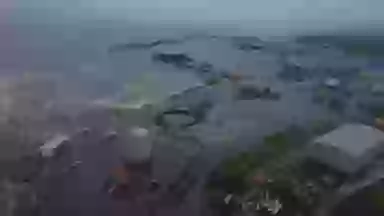Pacific Nations Brace for Tsunami After 8.8-Magnitude Earthquake Off Russia’s Coast
A Historic Earthquake Triggers Widespread Alerts
On July 30, 2025, an 8.8-magnitude earthquake struck off Russia’s Kamchatka Peninsula at 11:25 local time (00:25 BST), one of the strongest quakes ever recorded, tied for the sixth-largest in history, per the US Geological Survey. Centered 119 km east-southeast of Petropavlovsk-Kamchatsky at a shallow depth of 20.7 km, it unleashed tsunami waves up to 13 feet (4 meters) in Russia’s Kuril Islands, flooding ports like Severo-Kurilsk and damaging buildings, according to Reuters. Kamchatka Governor Vladimir Solodov called it “the strongest in decades,” with 3,000 evacuations reported. The quake, followed by aftershocks up to 6.9 magnitude and the eruption of Klyuchevskoy volcano, prompted tsunami warnings across the Pacific, from Japan to South America. President Donald Trump issued a stark warning on X, urging residents in Hawaii, Alaska, and the U.S. Pacific Coast to “STAY STRONG AND STAY SAFE” and monitor tsunami.gov, as waves were expected to hit multiple regions.
Areas Under Tsunami Threat
The earthquake’s shallow megathrust fault, where the Pacific Plate subducts under the North American Plate, triggered tsunami alerts across numerous Pacific nations, with varying wave heights and risks:
- Russia: Severo-Kurilsk saw waves of 3–5 meters, flooding ports and a fish processing plant, per RIA Novosti. Tsunami warnings were lifted by evening, but aftershocks up to 7.5 magnitude remain a concern, per Russia’s geophysical service.
- Japan: Nearly 2 million people in 133 municipalities from Hokkaido to Wakayama were ordered to evacuate, per Japan’s Fire and Disaster Management Agency. Waves up to 1.3 meters hit Hokkaido and Iwate, with a 60 cm wave at Hamanaka, per NHK. Warnings were downgraded to advisories by evening, but the Japan Meteorological Agency cautioned that larger waves could strike within a day.
- Hawaii: A 5.7-foot wave hit Kahului, Maui, and a 4.9-foot wave struck Hilo, per the Pacific Tsunami Warning Center. Warnings were downgraded to advisories by 10:40 p.m. HST, with no major damage reported. Governor Josh Green noted “no wave of consequence,” allowing evacuees to return, per Hawaii News Now.
- United States (West Coast): Northern California, from Cape Mendocino to the Oregon border, remained under a tsunami warning, with a 3.6-foot wave in Crescent City, per Reuters. Advisories covered parts of California, Oregon, Washington, and Alaska’s Aleutian Islands, with minor tidal fluctuations in San Francisco and Monterey, per National Weather Service.
- Chile: Upgraded to the highest warning level, Chile evacuated Easter Island and coastal areas, with waves up to 3 meters possible, per the US Tsunami Warning Center.
- Ecuador: The Galápagos Islands closed visitor sites, and coastal evacuations were ordered, with waves up to 1.5 meters expected, per INOCAR.
- Peru: 65 of 125 Pacific ports were closed, and coastal roads like Lima’s Costanera were shut, with waves of 1–2.3 meters expected, per the Peruvian Navy.
- Colombia: Red alerts were issued for Chocó and Nariño, with beach evacuations ordered, per National Unit for Disaster Risk Management.
- French Polynesia: The Marquesas Islands expected waves of 1.1–2.5 meters, lower than initial 4-meter forecasts, with evacuations to higher ground, per the High Commission of the Republic.
- Other Pacific Nations: Alerts or advisories were issued for the Philippines, Indonesia, Mexico, Costa Rica, Guatemala, El Salvador, New Zealand, Papua New Guinea, Solomon Islands, Fiji, Samoa, Tonga, Kiribati, Nauru, the Cook Islands, Guam, and the Northern Mariana Islands, with expected waves of 0.3–3 meters and risks of strong currents, per Al Jazeera and NOAA.
The Science and Danger of Tsunamis
Tsunamis, as explained by NOAA, are series of long ocean waves triggered by sudden ocean displacements, often from shallow earthquakes like this one, which account for 80% of tsunamis. Traveling at jet-plane speeds (up to 500 mph) in deep water, they slow and gain height in shallow coastal areas, causing devastating flooding and currents that can last days. Dave Snider of the National Tsunami Warning Center noted, “Tsunamis are not just one wave. They’re a series of powerful waves over a long period,” with later waves potentially larger. The 2011 Japan tsunami, triggered by a 9.0-magnitude quake, killed over 15,000 and caused the Fukushima nuclear disaster, underscoring the risk. While no major damage or fatalities were reported by July 30 evening, experts like Robert Weiss of Virginia Tech warned of potential destruction, comparing it to the 2004 Sumatra and 2011 Tōhoku tsunamis.
Evacuations and Regional Responses
Mass evacuations unfolded across affected regions. In Japan, residents fled to hilltops and rooftops, recalling the 2011 disaster, with ferries and flights suspended, per The Independent. Hawaii saw gridlocked traffic in Honolulu and Oahu, with Black Hawk helicopters on standby, per NBC News. Chile evacuated Easter Island’s 3,000 residents to higher ground, while Ecuador’s Galápagos saw controlled evacuations, per CNN. Russia’s Severo-Kurilsk residents were moved to safety, and Peru closed coastal access points, per The Guardian. Trump’s warning, echoed by posts like @NWS’s on X, urged vigilance, directing people to tsunami.gov. Despite downgraded warnings in many areas, advisories persisted, with NOAA cautioning about dangerous currents and minor flooding risks.
A Narrow Escape with Ongoing Risks
By late July 30, Japan, Hawaii, Russia, and parts of the U.S. West Coast downgraded warnings, with no significant damage reported, per The New York Times. Hawaii’s Governor Green and US Homeland Security Secretary Kristi Noem confirmed the worst had passed, though advisories remained for Northern California and Pacific islands like Nuku Hiva, per BBC News. The Klyuchevskoy volcano’s eruption added complexity, with lava flows reported, per RIA Novosti. Experts warned of aftershocks and potential new waves, with Japan’s Meteorological Agency noting tsunamis could strike up to 24 hours later. The event, while less catastrophic than feared, highlighted the Pacific Ring of Fire’s volatility and the need for robust preparedness, as small waves still posed risks to low-lying areas like French Polynesia’s atolls, per Reuters.


